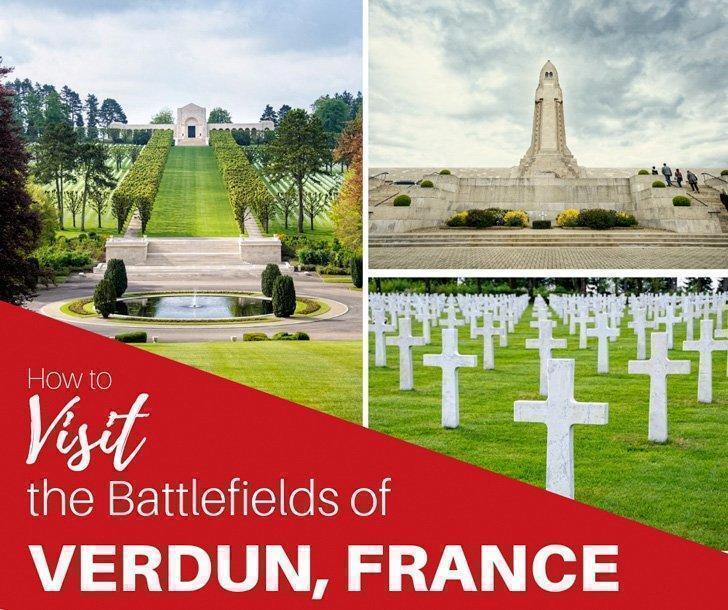
By the end of 1915, the war on the western front had ground to a halt. Trenches reached from the coast of Belgium to the Swiss border, and the lines would change little until 1918. The Battle of Verdun was one attempt to break through.
Surrounded by hills, Verdun sits along the Meuse River in the Grand Est region of France (formerly Lorraine). Strategically important due to its position on the river, Verdun was defended by a ring of forts, somewhat like the ring of forts around Liege and Namur. In the late 19th century, with mounting tensions between the French and Germans, the French military decided to upgrade Verdun’s defenses. This included adding reinforced concrete to the fort structures and upgrading the guns.
In February 1916, the German army launched an attack on Verdun that lasted 300 days. Before our visit to Verdun, I knew little about Verdun or the battle that ensued. I’ve read about it, but only in the context of how the battle affected other aspects of the larger war. So, one beautiful Saturday morning in April, Alison and I joined the Expat Club on a day trip to the area around Verdun.
Meuse-Argonne American Military Cemetery and Memorial
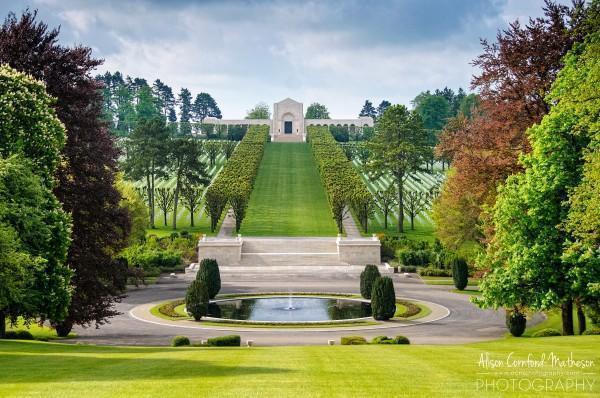
Meuse-Argonne American Military Cemetery and Memorial is a beautiful and peaceful final resting place.
Our first stop was the Meuse-Argonne American Military Cemetery and Memorial. Covering 130 acres and containing 14,246 graves, it is the largest American military cemetery in Europe. Although not related to the Battle of Verdun, as the Americans had not yet entered the war, they are significant to the story of the area.
In September 1918, the American army, numbering 1.2 million soldiers, attacked the Germans and applied unrelenting pressure until the armistice. This cemetery contains the graves of the men who died in this final battle of the war.

The cemetery’s small chapel overlooks the graves.
Grave markers cover the slope of a hill, stretching towards a chapel. From the welcome centre, the sweep of the white crosses, clearly visible against the green grass, is a remarkable sight.
Inside the chapel, stained glass, depicting the insignia of American units, throws various colours against the white stone of the walls. To either side of the chapel, the names of 954 missing soldiers are inscribed.
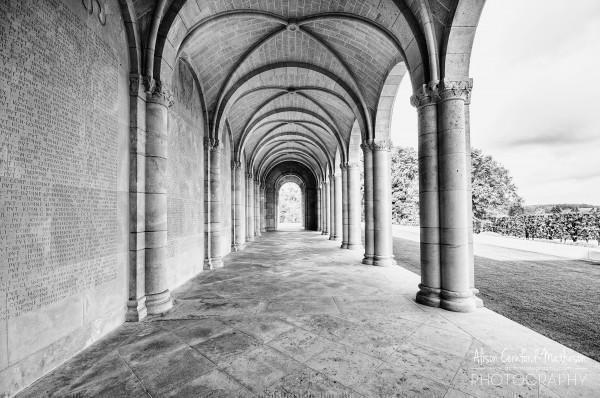
A haunting tribute to the missing soldiers.

Countless names of fallen soldiers are inscribed on the wall.

A sea of graves mark the fallen and include women and even children who died here.
It is a beautiful memorial and well maintained, although it almost feels forgotten. The cemetery is quiet and still. When we arrived on the tour bus, there was only one other car.
According to the cemetery’s caretaker, few Americans make it to this cemetery. This is in contrast to some of the larger British Commonwealth cemeteries, further north, which are popular stopping places for tourists visiting Ypres. Regardless, the quiet and stillness is an important contrast to the noise and violence of these many deaths.

So many battles. So many lives lost.
Trench of the Bayonets
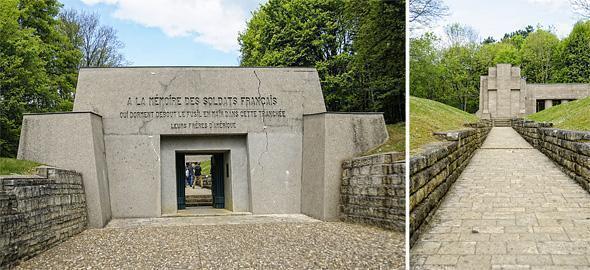
The stark entrance to the Trench of the Bayonets
From the cemetery, the bus made a short stop at the Trench of the Bayonets. This site commemorates soldiers found buried in 1919, their rifles sticking out of the ground.
Legend says they were preparing to attack when an exploding shell buried them. The likely reality is they were buried in a shallow trench with their rifles used as markers.
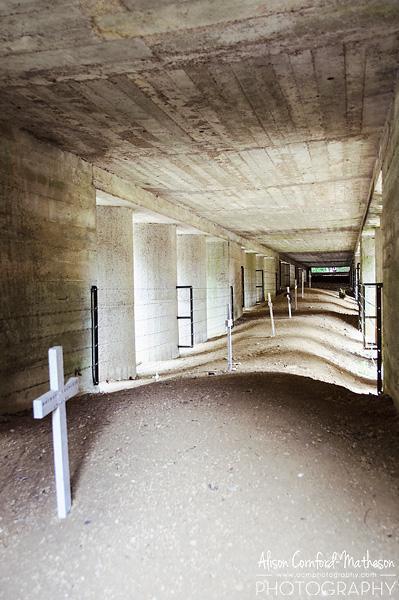
A powerful tribute to the soldiers buried here.
Nonetheless, the legend caught the imagination of the public, and a memorial was created. Regardless of the facts, the impressive memorial captures the moment when men were buried in makeshift graves.
The rest of the land has somewhat recovered from the ravages of war, but here the memorial is purposely raw – concrete and dirt.
Douaumont Ossuary
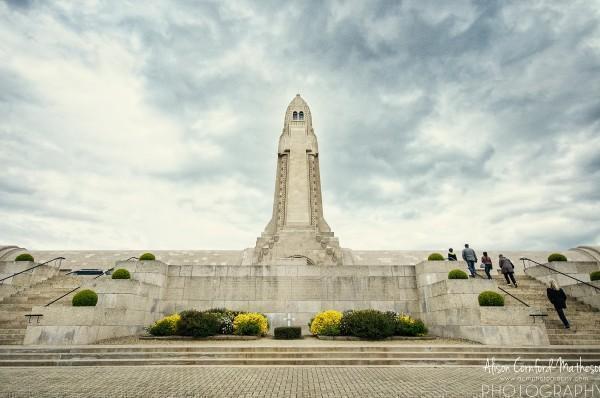
The Douaumont Ossuary is a unique tribute to the casualties of WWI
After a short lunch stop, the tour group proceeded to the Douaumont Ossuary. From February 21 to 18 December 1916, the Battle of Verdun raged between the French and the Germans.
In 300 days, over 26 million artillery shells were fired, and more than 700,000 men were killed or injured. It is estimated up to 300,000 men died during this battle. However, due to the conditions, not all the bodies could be identified.
Immediately following the armistice, in 1918, the governor and mayor of Verdun decided to build an ossuary in commemoration of the lives lost.
Started in 1920 and officially unveiled in 1932, the ossuary features a 46-meter tower, ‘The Lantern of the Dead,’ with a panoramic view over the battlefield, a chapel, and a long hall with a grave marker for each battle zone around Verdun.
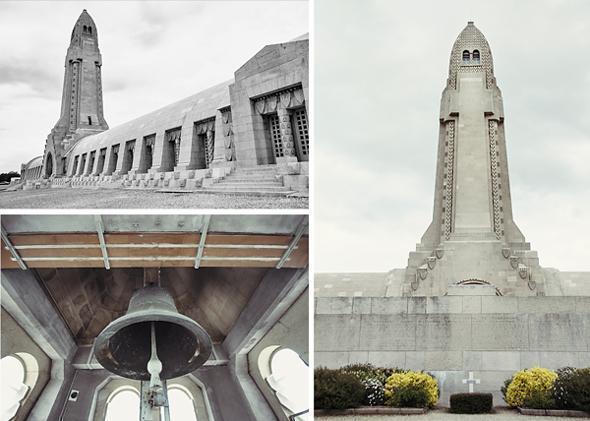
The Lantern of the Dead stands guard over the bones of unknown soldiers from both sides of the battle.
The most significant feature lies beneath the building: the remains of at least 130,000 soldiers. From the outside, windows in the building’s foundation allow visitors to see into the crypts and witness the jumbled piles of bones. It is a staggering sight.
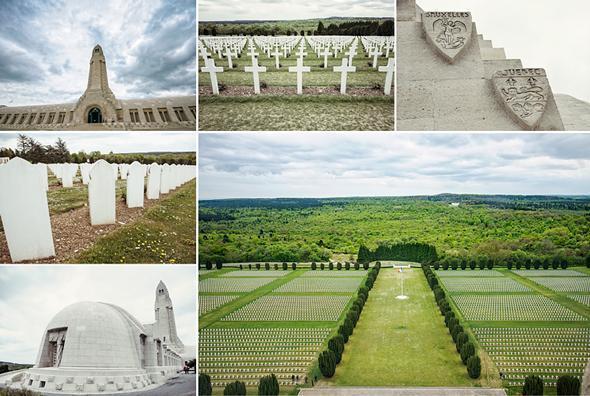
The view from the top is chilling, and the grave commemorates soldiers from around the world.
This was my first experience visiting a mass grave. Like the American cemetery, the scale struck me the most. I can’t begin to understand the horror of the battles, but these sites point to just how extreme the situation was around Verdun.
The memorial’s inclusiveness also impressed me. It is not simply a French monument, but it includes soldiers from both sides of the conflict. This is unusual. In my experience, graves and memorials have been kept distinctly separate.
I admire the decision to bring both sides together in one shared memorial. Quite significantly, on Sept 22, 1984, German Chancellor, Helmut Kohl, and French President, Francois Mitterand, stood at the Douaumont Ossuary holding hands as a symbol of Franco-German reconciliation. For all sides, the Douaumont Ossuary is an important reminder of the cost of war.
Fort de Douaumont
Our next stop was Fort Douaumont, deemed the most important fort in the ring of defence around Verdun. On paper, it was also the most heavily armed. However, after the fall of the Belgian forts to the German howitzer, Big Bertha, the French military command deemed Fort Douaumont and the other forts ineffective against modern artillery. This meant by February 1916, the fort was partially disarmed and only lightly garrisoned.
When the German army launched their campaign on Verdun on February 21, 1916, Fort Douaumont was a key piece in the defence. The German artillery shelled the fort, forcing the skeleton crew of soldiers down to the lowest levels to escape the danger.
A German patrol advanced and, meeting no resistance, gained entry. Once inside, the Germans captured the French soldiers without firing a shot. Fort Douaumont, the strongest fort of Verdun, was now in German hands.

The noise inside the Fort Douaumont must have been deafening.
Our tour guide walked us through the fort, explaining the situation of the French soldiers left holding the fort against the Germans. Like the Liege forts, the sound and concussion of the artillery barrage must have been deafening. At one point, our guide simulated the noise of an exploding shell by dropping a metal grate. The sudden, sharp clap of steel hitting the floor was intense. I was astonished at how the sound reverberated through the tunnels. The noise must have been horrendous when the fort was under fire.
The French decision to all but abandon the forts would prove to be a costly one. Fort Douaumont became a critical shelter and base for German forces, just behind the front line. It would take several attempts and tens of thousands of lives to recapture the fort.
During the visit to Fort Douaumont, our guide showed us the barracks, the sanitation and water facilities, and the remaining 155mm gun cupola. Unexpectedly, we also visited a German war grave within the fort itself. In May 1916, a fire caused a devastating sequence of explosions, resulting in 679 deaths. The remains were gathered inside a section of the fort and permanently walled off.

The fort’s exterior bears the scars of heavy fighting
After exiting the fort, we climbed onto the superstructure. The exterior bears the scars of the numerous artillery shells and the landscape is dotted with huge craters. It is remarkable, and a testament to the construction, the interior held up to the pounding.
Village Detruit – Fleury devant Douaumont
Our final stop was another reminder of the devastation of the First World War. We visited the former village of Fleury (Fleury devant Douaumont). I say former because, other than some street signs and a chapel, the village is gone.
Destroyed during the numerous battles and artillery shelling around Fort Douaumont, the French government decided not to rebuild it. Instead, Fleury and eight other villages, remain silent memorials of all the material and social damage caused by the war. It is a remarkable feeling to walk through a ghost village.

The destroyed village of Fleury devant Douaumont is possibly the most powerful of all the sites we visited. The quiet path through the craters is all the remains besides the small chapel.
To finish our day, we made a short stop in the town of Verdun. We walked along the Meuse, grabbed a bite to eat, and reflected on all we had experienced that day. It is a pleasant town and seemed laid back – a good spot to stop during a visit to the region. Back on the bus, we returned to Brussels.
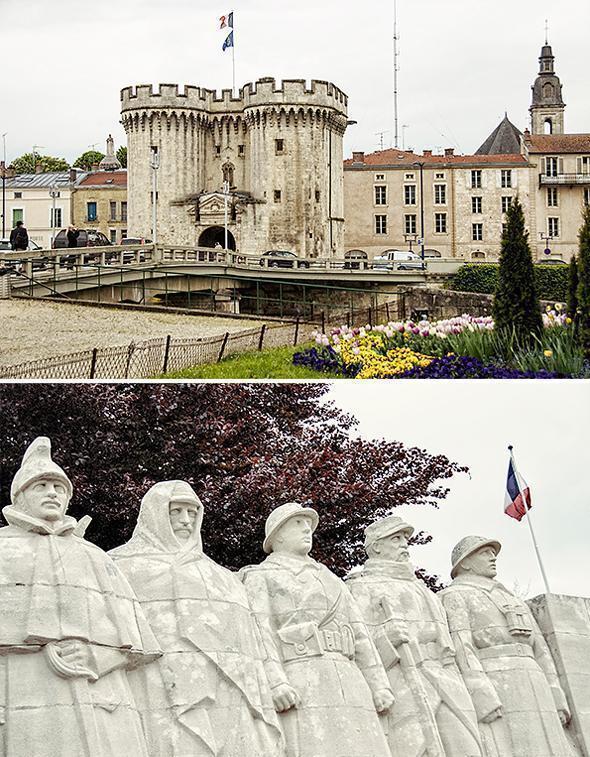
The town of Verdun, France has more to offer than just memorial sites.
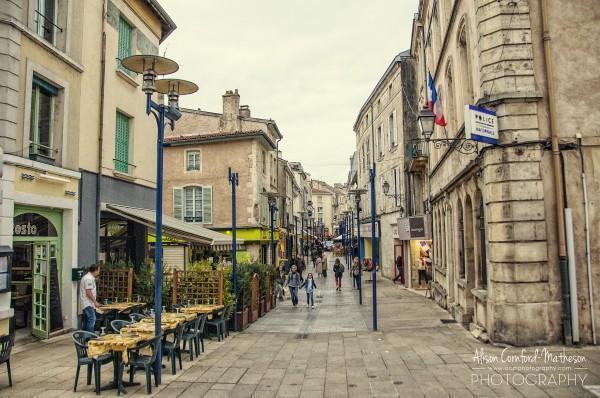
The bustling town hardly reveals the secret of its terrible past.
This was my third trip with the Expat Club (I’ve now done four). Edgar, the club’s founder, does an excellent job organizing these day trips. When you consider the planning and coordination, the price he charges is an incredible value for money. Not only does he arrange the transportation, but he also secured a guide who joined us and provided additional insight about the sites. These tours are also great for meeting like-minded people because you are sharing an experience together. Most importantly, I can relax and Edgar takes care of the rest.
Our visit to Verdun was emotional and informative. I had read of the Battle of Verdun but my knowledge was limited. Being there and learning more about the situation helped me better appreciate the role Verdun played in the larger picture. It is also staggering to learn there were over 700,000 casualties during this battle, known as the “Hell of Verdun.” I can now understand why.
If you want more information about upcoming tours, check out the Expat Club website and join the mailing list. There are tours most weekends, as well as more social events throughout the week. Some of the tours might seem eccentric (Audi Factory Tour, Doel Nuclear Power Plant Tour, UPS Sorting Facility Tour), but I assure you they are all deeply interesting. I’ve done both the Audi and UPS tours and highly recommend them.
Have you attended one of the Expat Club tours? We’d love to hear about your experience in the comments below.
For a full listing of our articles like this one, visit our Memorial Tourism in Belgium page.

Like this article? Save it to Pinterest!
- Wise Review: How to Save Money on International Currency Transfers - January 20, 2017
- Our 50+ Best Belgium Gifts Online - November 29, 2016
- Review: Crowne Plaza – Le Palace Hotel and Restaurant, Brussels, Belgium - September 30, 2016
- Visiting The Battlefields of Verdun, France
- Exploring the Battlefields of Ypres, Belgium
- Ypres World War One Museums
- Visiting the Fort de Loncin WWI Memorial Site, in Liege, Belgium
- Visiting the Atlantic Wall Museum, Oostende, Belgium
- Bastogne WW2 War Museum, Belgium
- Visiting the Bastogne Barracks and the Vehicle Restoration Centre, Wallonia, Belgium
- Visiting the Fort de Barchon in Liège, Belgium
- Visiting Fort Eben-Emael in Liège, Belgium
- Top 10 War Memorials for Canadians in Europe
